Kisumu City on Lake Victoria - Transport Challenges
Kisumu city is third largest in Kenya
Kisumu is Kenya's third-largest city after Nairobi and the port city of Mombasa. It is the second largest in the Lake Victoria basin, after Kampala in Uganda. Kisumu’s origins as a town can be traced to the arrival of the Uganda Railway in 1901 from the port of Mombasa. The train went into service in 1903. The terminus was first called Port Florence, though the locals called it Kisuma. This was later changed to Kisumu. It is likely that the locals met at Kisuma for barter trade long before the arrival of the railway. Ancient pictures show a thriving market in Kisumu. The gulf on which Kisumu (1,131 m, 3,711 ft above sea level) is situated is called Winam Gulf and is part of the larger Kavirondo Gulf on Lake Victoria. Lake Victoria is the second largest freshwater lake in the world and together with the Blue Nile in Ethiopia, it is a source of the River Nile. The city is the headquarters of Kisumu County, whose governor is Professor Anyang Nyongo, the father of the famous movie actor, Ms. Lupita Nyongo. One can get to Kisumu by road, air, or boat, depending on which direction or country one is coming from.
Today the Mombasa railway line to Kisumu has been so neglected and no longer runs a passenger service. There are plans to connect Kisumu with the Standard Gauge Railway line that now operates between Mombasa and Nairobi. The extension of this SGR line from Nairobi to Naivasha, which is a quarter of the way to Kisumu, is already underway.
How big is Kisumu City?
Kisumu is not a very big city. It is estimated to have about 500,000 inhabitants (less if you go by the 1999 census). This is less than a quarter of the inhabitants of Nairobi, the capital city of Kenya that has slightly over three million inhabitants. Walking along the streets does give you the feeling of freedom that one does not get in Nairobi, where one is likely to be knocked about by other pedestrians and their luggage. For the moment, hawking of wares is not a common sight but this luxury may be short-lived if other Kenyan cities are anything to go by. Begging is also not widespread.
As you can see in the pictures above, the pavements, which should really be reserved for pedestrians, are not respected by motorists. Pedestrians are therefore forced to share the road with vehicular traffic.
Transport Options in the City
In Kisumu City, you can easily move about by walking or by riding on bicycles known as Border-boarders. These are passenger bicycles that charge a fraction of what taxis charge. They are slowly being driven out of business by motorcycles.
The common term for bicycle transport is 'bodaboda.' Apparently they were popular at the border between Kenya and Uganda when motorised transport was scarce. Now they are in every town in Kenya as alternative transport.
Bicycles charge a fraction of what other motorised transport charges. Where a motorcyclist will charge Sh. 50/=, cyclists charge only Sh. 20/=. Cyclists in Kisumu are numerous as a result of these low charges. This is really a bicycle city. They line up beside cars at traffic lights, creating quite a sight. The riders are very aggressive and will not hesitate to nudge motorcardrivers off the limited road space. This will happen with you sitting at the back, holding onto your seat.
Motorized Transport
Motorised transport includes:
Three-wheeler Tuk tuk
The three-wheeled scooter is called a 'Tuktuk.' This name comes from the sound of its motor. Tuktuks are licensed to carry only three passengers, but it is not unusual to see two extra passengers—one next to the driver. Expect to pay about three times what a motorcycle would charge. They are more popular in Kisumu than they are in Nairobi. Perhaps due to the cost, Kisumu residents prefer motorcycles unless one has luggage or family members. But from the picture of a heavily laden motorcycle above, the tuk-tuks face stiff competition from the two-wheelers.
Motorcycle Transport
The bicycle provided cheap transport to the ordinary person on the street. But as the city grew and the economy picked up, there was a need to move about faster.
Motorbikes were a natural progression from the bicycle, saving the passenger much-needed time at an affordable cost. Motorbikes are literally driving bicycles out of town and soon only the deep interior will tolerate rides by a panting cyclist who has to request you to disembark when riding uphill. You will find public transport motorcycles parked at all city corners revving to compete for passengers.
Motorcycles are, however, notorious for flouting traffic rules, especially carrying more than two passengers, as you see in the photos. What is intriguing is the extent to which people will risk their lives to be transported in groups of threes, fours, and more on a motorbike, sometimes in the full glare of a traffic policeman.
Both riders and travellers rarely use safety helmets and reflector jackets as required by the law.
Matatu (minivan) Transport
Matatu—These are 13-seater minivans that are popular all over Kenya for local and long-distance travel. They are by law required to have an identifying yellow line across the entire length and each minivan should not operate in isolation but should belong to a registered company. These public transport companies are referred to as SACCOs.
Sailing on the lake
The lake joins the three East African countries of Kenya, Uganda, and Tanzania. Visitors to Kisumu can go for sightseeing by boat. Each passenger is given an orange life jacket. There are some fishing boats that have been fitted with sails, just like dhows in the Indian Ocean.
Previously there were large boats that were operated by the former East African Railways and Harbours. When this organisation collapsed in the early eighties, each country nationalised the assets in its territory, leading to the collapse of organised transport between Kisumu and the other East African ports of Mwanza, Musoma, Bukoba, and Jinja. Following the revival of the East African Community, plans are underway to construct a modern port and resume shipping on the lake.
Fishing boats
Pollution on Lake Victoria
For a long time the lake was choking with plastics and effluents from surrounding industries. Fortunately Kenya has banned the use of plastic papers, which has gone a long way in ensuring a cleaner lake. However, plastic bottles, whose use should also be banned, are still a nuisance. Another menace is the washing of vehicles at the lake shores, which is another source of pollution, as can be seen in the photo below. The car washers are taking advantage of the lake's free water while ignoring the adverse effects of vehicle fuels, lubricants, and detergents on the lake. Hopefully as the new port is being constructed, this business will come to a halt.
Have you ever been to Kisumu City? If so what was your experience? If you haven't been to Kisumu, you need to make an appointment with this fast-growing city.

Kisumu is Kenya's third-largest city after Nairobi and the port city of Mombasa. It is the second largest in the Lake Victoria basin, after Kampala in Uganda. Kisumu’s origins as a town can be traced to the arrival of the Uganda Railway in 1901 from the port of Mombasa. The train went into service in 1903. The terminus was first called Port Florence, though the locals called it Kisuma. This was later changed to Kisumu. It is likely that the locals met at Kisuma for barter trade long before the arrival of the railway. Ancient pictures show a thriving market in Kisumu. The gulf on which Kisumu (1,131 m, 3,711 ft above sea level) is situated is called Winam Gulf and is part of the larger Kavirondo Gulf on Lake Victoria. Lake Victoria is the second largest freshwater lake in the world and together with the Blue Nile in Ethiopia, it is a source of the River Nile. The city is the headquarters of Kisumu County, whose governor is Professor Anyang Nyongo, the father of the famous movie actor, Ms. Lupita Nyongo. One can get to Kisumu by road, air, or boat, depending on which direction or country one is coming from.
Today the Mombasa railway line to Kisumu has been so neglected and no longer runs a passenger service. There are plans to connect Kisumu with the Standard Gauge Railway line that now operates between Mombasa and Nairobi. The extension of this SGR line from Nairobi to Naivasha, which is a quarter of the way to Kisumu, is already underway.
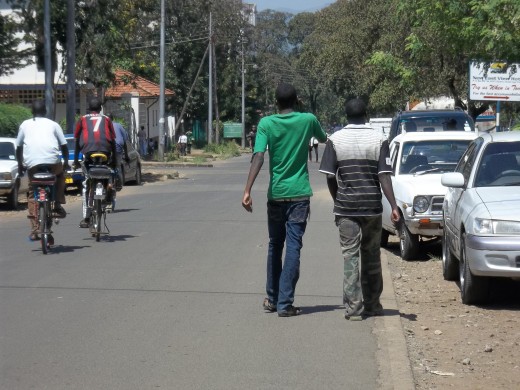 |
| Walking is the easiest way to get around in Kisumu. |
How big is Kisumu City?
Kisumu is not a very big city. It is estimated to have about 500,000 inhabitants (less if you go by the 1999 census). This is less than a quarter of the inhabitants of Nairobi, the capital city of Kenya that has slightly over three million inhabitants. Walking along the streets does give you the feeling of freedom that one does not get in Nairobi, where one is likely to be knocked about by other pedestrians and their luggage. For the moment, hawking of wares is not a common sight but this luxury may be short-lived if other Kenyan cities are anything to go by. Begging is also not widespread.
As you can see in the pictures above, the pavements, which should really be reserved for pedestrians, are not respected by motorists. Pedestrians are therefore forced to share the road with vehicular traffic.
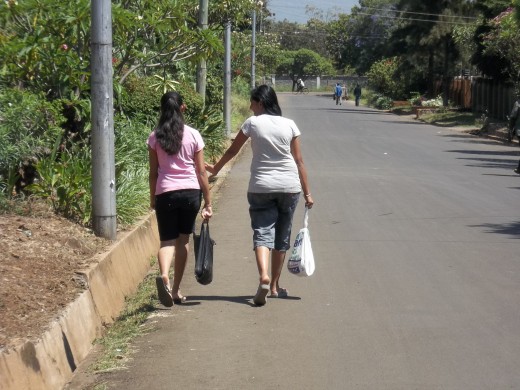 |
| Kisumu is a multi-ethnic and multiracial city |
In Kisumu City, you can easily move about by walking or by riding on bicycles known as Border-boarders. These are passenger bicycles that charge a fraction of what taxis charge. They are slowly being driven out of business by motorcycles.
The common term for bicycle transport is 'bodaboda.' Apparently they were popular at the border between Kenya and Uganda when motorised transport was scarce. Now they are in every town in Kenya as alternative transport.
Bicycles charge a fraction of what other motorised transport charges. Where a motorcyclist will charge Sh. 50/=, cyclists charge only Sh. 20/=. Cyclists in Kisumu are numerous as a result of these low charges. This is really a bicycle city. They line up beside cars at traffic lights, creating quite a sight. The riders are very aggressive and will not hesitate to nudge motorcardrivers off the limited road space. This will happen with you sitting at the back, holding onto your seat.
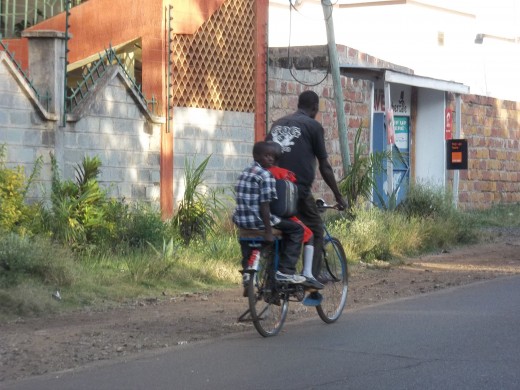 |
| No need to take two bicycles when one will do! |
Motorised transport includes:
- Motorcycles
- Three-wheel scooters
- 13 sitter minivans
- Motorised boats on the lake.
Three-wheeler Tuk tuk
The three-wheeled scooter is called a 'Tuktuk.' This name comes from the sound of its motor. Tuktuks are licensed to carry only three passengers, but it is not unusual to see two extra passengers—one next to the driver. Expect to pay about three times what a motorcycle would charge. They are more popular in Kisumu than they are in Nairobi. Perhaps due to the cost, Kisumu residents prefer motorcycles unless one has luggage or family members. But from the picture of a heavily laden motorcycle above, the tuk-tuks face stiff competition from the two-wheelers.
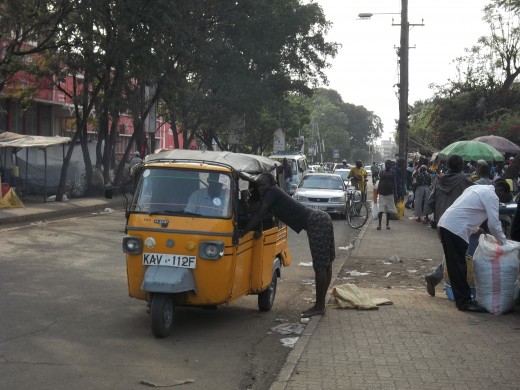 |
| negotiating a good price |
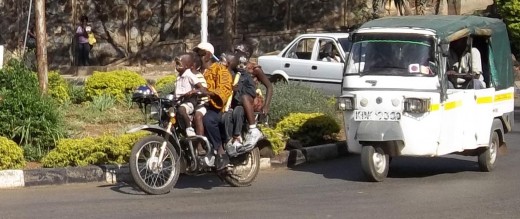 |
| Compare Motorcycle and Tuk Tuk Transport. Note also the overloading! |
Motorcycle Transport
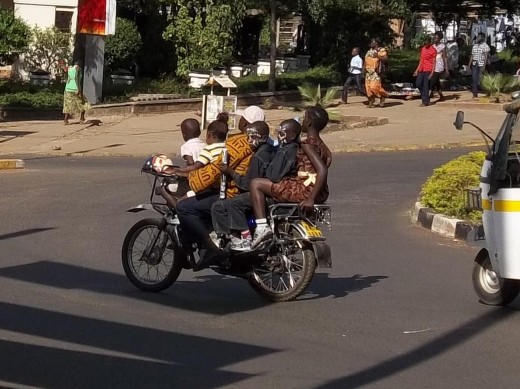 |
| Well... this is clearly against the law. |
The bicycle provided cheap transport to the ordinary person on the street. But as the city grew and the economy picked up, there was a need to move about faster.
Motorbikes were a natural progression from the bicycle, saving the passenger much-needed time at an affordable cost. Motorbikes are literally driving bicycles out of town and soon only the deep interior will tolerate rides by a panting cyclist who has to request you to disembark when riding uphill. You will find public transport motorcycles parked at all city corners revving to compete for passengers.
Motorcycles are, however, notorious for flouting traffic rules, especially carrying more than two passengers, as you see in the photos. What is intriguing is the extent to which people will risk their lives to be transported in groups of threes, fours, and more on a motorbike, sometimes in the full glare of a traffic policeman.
Both riders and travellers rarely use safety helmets and reflector jackets as required by the law.
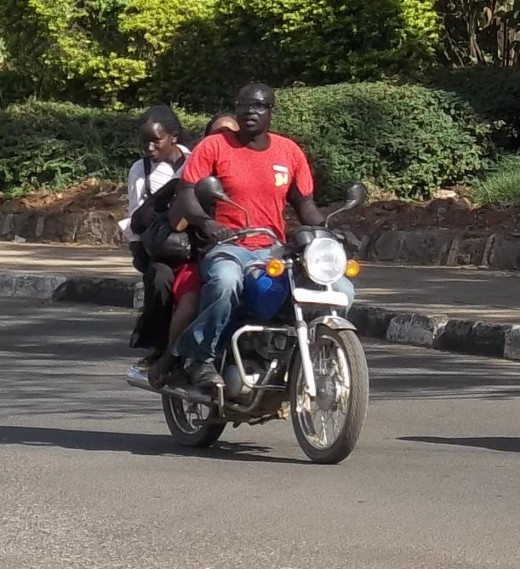 |
| Two passengers |
Matatu (minivan) Transport
Matatu—These are 13-seater minivans that are popular all over Kenya for local and long-distance travel. They are by law required to have an identifying yellow line across the entire length and each minivan should not operate in isolation but should belong to a registered company. These public transport companies are referred to as SACCOs.
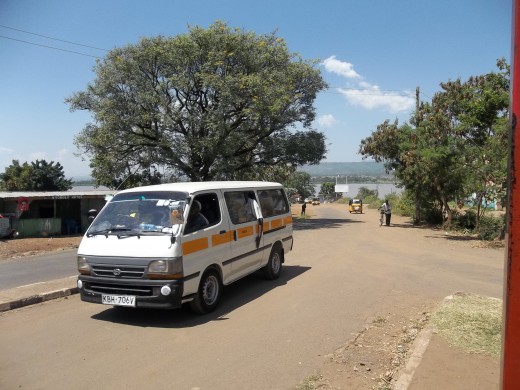 |
| Add caption |
Sailing on the lake
The lake joins the three East African countries of Kenya, Uganda, and Tanzania. Visitors to Kisumu can go for sightseeing by boat. Each passenger is given an orange life jacket. There are some fishing boats that have been fitted with sails, just like dhows in the Indian Ocean.
Previously there were large boats that were operated by the former East African Railways and Harbours. When this organisation collapsed in the early eighties, each country nationalised the assets in its territory, leading to the collapse of organised transport between Kisumu and the other East African ports of Mwanza, Musoma, Bukoba, and Jinja. Following the revival of the East African Community, plans are underway to construct a modern port and resume shipping on the lake.
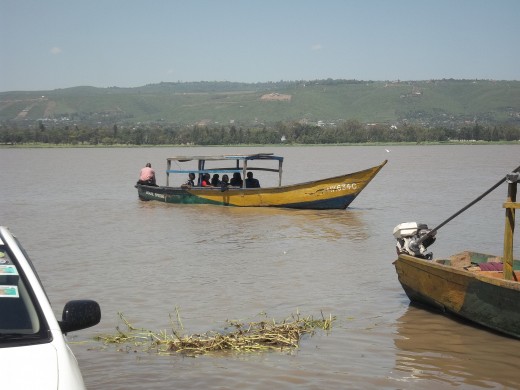 |
| A motorboat with passengers |
Fishing boats
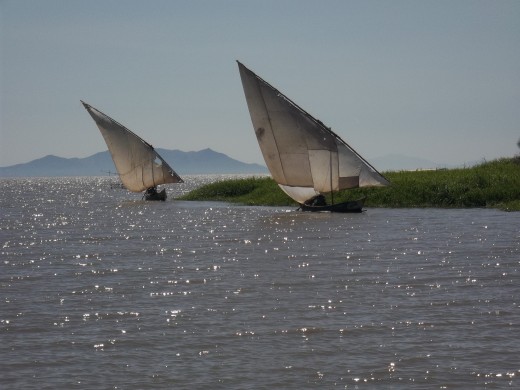 |
| Sail boats returning from a fishing expedition at Dunga point |
Pollution on Lake Victoria
For a long time the lake was choking with plastics and effluents from surrounding industries. Fortunately Kenya has banned the use of plastic papers, which has gone a long way in ensuring a cleaner lake. However, plastic bottles, whose use should also be banned, are still a nuisance. Another menace is the washing of vehicles at the lake shores, which is another source of pollution, as can be seen in the photo below. The car washers are taking advantage of the lake's free water while ignoring the adverse effects of vehicle fuels, lubricants, and detergents on the lake. Hopefully as the new port is being constructed, this business will come to a halt.
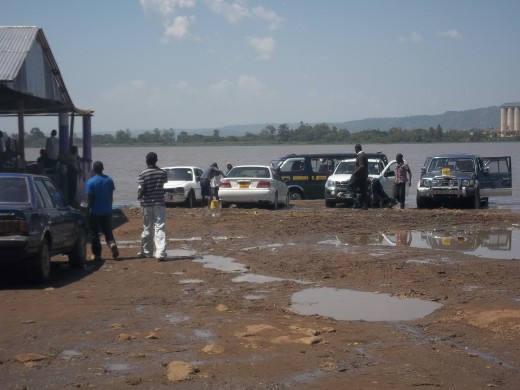 |
| Besides directing industrial effluents and sewage into the lake, car washing is another menace |

Preserving Kenya's memory takes time, care, and community support.
If this post added to your understanding, Buy Me a Coffee and help keep these stories alive.



Comments
Post a Comment
Your comments are very important to this blog. Feel very free to make your opinion known. We will respect it.